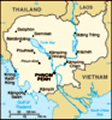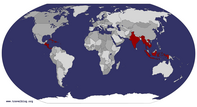Advertisement
Published: February 22nd 2015
The hill outside Kampot was unremarkable. The man at my guesthouse told me local people went there to send out their wishes, but tourists didn’t bother visiting. It was just a rather ordinary place. But that was what I wanted during my final few days in Cambodia. Mostly, I wanted a place with no other tourists.
The motor scooter sputtered up the rough asphalt path, past a few houses where people and dogs lounged about. After a short climb we stopped in an area that appeared to be under construction. Piles of wood, metal, gravel, and dirt were strewn about. A low building with a shiny floor housed a temple. Nearby, odd concrete pillars jutted into the sky. The strangest structure was a pile of metal, geometric interlocking pieces that laid atop one another, layer cake fashion, like a stiff metal Christmas tree. I thought it was weird, not worthy of a photo even, because it was rough and appeared unfinished.
At the top of a small hill was a monk, washing himself and laundry. Orange robes hung around, bright against the slab of grey concrete. The monk directed us past a temple, toward the hill higher
up, where my driver and I found a small building with a large male figure inside. Far below the river snaked through the Kampot countryside with hills dotting the landscape. I was hot as the sun tried to peek through the clouds.
On the way down the hill to the larger temple was a small shrine with a figure of an old man inside. What intrigued me was the pile of rusty nails, set as an offering. At the large temple nearby, iron rebar was everywhere--long ribbed sticks in loose piles, pieces fabricated into railings and pot holders, and coiled into springlike objects as long as an arm and piled before the Buddha statues.
“Why all the metal?” I asked my driver in the Khmer language. He didn’t know. The monk, who seemed to have been watching me, wanted to give us bottles of water and soda. From atop a platform, the smiling monk reached down with the drinks, and I carefully took them, knowing that I shouldn’t touch him.
I suspected the drinks were not for me, but were instead for an offering. Not knowing the protocol, I told my driver to
go first. He lit three sticks of incense, knelt, set the water and soda down, then held the incense aloft in prayer. He placed the lit incense in an urn. He lit my three incense sticks, and I copied his actions.
I knew the monk was watching. I knew my driver was watching. When I travel in other countries I try to be respectful and do as the locals do, especially while in sacred places. So although I’m not a Buddhist, nor a Christian, nor am I affiliated with any organized religion, I felt I should go through the motions. But this place was getting to me—something was special, something was speaking. The smiling monk had given me these offerings, and this place, although quite understated compared to Angkor Wat and all the other cool places I’d been in Cambodia, was different. I would do more than just go through the motions.
I prayed. I hardly ever pray, but I prayed there, while on my knees in front of Buddha and piles of metal. I held the incense high, and I thought good thoughts. But mostly, I held an image of joy. I smiled,
and I felt joy.
I opened my eyes, and they settled on the coils of heavy metal, lined up in offering. They contrasted so starkly with all the Buddhas and other figures. I asked my driver again, why the metal? He pointed to the monk, who beckoned.
I crawled atop the floor of the monk's shelter and tucked my legs behind me. My driver sat on the edge. The large photo of a monk on the wall was the very same monk sitting beneath it. I looked at him, and asked, why all the metal? He stood.
From behind sliding glass doors, the monk started pulling out metal objects, shaped into intricate sculptures and designs. There was a bow that he drew back, taking aim as a hunter would. He donned a quiver of iron arrows. There was a giant candelabra-looking thing, with curly cues and swirls, and strange metal gadgets of all sizes that he pushed and twanged, each with a different tone. Smiling, he pulled out long and short coiled corkscrews. Then he showed me his tools. A metal hammer. A metal axe.
I was getting a good feeling. This
man was different. He seemed to live in a world of fancy, of revolution, of swirls, of creation. His eyes were so bright and happy, his skin was smooth and youthful. His orange robes glowed. He had no age, he just had joy. I was in the presence of a brilliant man.
He pointed to the fabric hanging in the room behind glass, and said he sewed it all. There was a multicolored flag of sorts, and he pointed to each section of color, counting backwards from 12. He said it was very difficult to sew.
He could see I was spellbound. He appeared with a roll of white papers, squatted near me, and began unfurling them. Intricate drawings depicted his building plans for the area. Then I remembered the unfinished metal sculptures, foundations of buildings, rebar sticking out, awaiting more materials.
Each plan that he unfolded seemed ever more elaborate. I saw mandalas blossoming, repeating themselves, all bound together in an expansive design. He tried to explain the ideas behind the drawings. There were markings, Khmer letters and numbers, written in tiny but precise script, labeling the lines and the angles. He said
something about twelve, and I sensed progression, a timepiece, an ordering of the world. A plan for a boat structure was sectioned precisely and symmetrically. The drawings suggested a birthing, making the unknowable real, making sense out of chaos. My mouth dropped open. I looked at this man, all joyful and playful, infecting me with his smile, and he was showing me his vision.
I wished I were fluent in Khmer. I wanted to ask him so many questions, probe his mind. But instead, my intuition and the feelings I was getting from his sculptures and drawings had to suffice. Somehow I sensed there was truth in what this monk was creating.
He said the ideas were difficult to understand. But, I thought, if I only had a little more time, a firm grasp of the language, I could understand.
I asked him if these ideas came in a dream. He said no, then spoke in Khmer that I didn’t understand. I pointed to the heavens, he nodded a little. What I sensed was his practice as a Buddhist monk had given him these ideas, and he was translating them
into reality. He tried to make me understand, and said something about strange ideas.
He didn’t know when his plans would reach fruition. It depended on people bringing him money. He got donations for pieces of fabric with ancient writing on them, which supposedly bring people luck.
By then he was eating, sitting behind his low table. He had a pile of rice and a bowl of vegetables. He told me he ate only sticky rice, vegetables, peanuts, no meat, no eggs.
Then he handed me a glob of rice on a pot lid and told me to eat. It stuck all over my fingers. I just wanted a taste, but he told me to eat. I couldn’t refuse the food gift from the wise man. I ate it all.
Then he told me that he had never shown anyone his metal creations before. He had never shown anyone the plans. He said he could see there was something about me, and he wanted to share these things with me.
The wise joyful man was telling me this and I was filled with wonder, filled with gratitude. He
said he could tell I would have much luck in the future, I would have good fortune.
I leaned against a post and wanted to spend the rest of the afternoon there, just being with the monk who was birthing ideas. I asked about his past. He said he was from Siem Reap, from Bantey Srei, a temple in the Angkor Wat complex that I had visited. He had been at that place outside Kampot now for ten years. He asked about me, how long I'd been in Cambodia, what I was doing in the village Chi Phat. I think I made a mistake with my Khmer when I said I was helping the guides there. I think I said something about peeing because the words are similar, so he repeated the Khmer words for me with a smile.
And because this man showed interest in me, I started getting stupid. Yes, stupid. I talked about volunteering in Chi Phat, and how it was so wonderful, and how it felt like home, and now I had family there, and my voice cracked, and I wanted to cry.
Stop it, I scolded
myself. He didn’t want to hear that. So I stopped talking about Chi Phat.
I had stayed a long time; my driver was restless. I thought, I should go, even though I wanted so much to stay. I placed a small donation in a glass box and got up. But the monk called me back. He thrust a bill-sized paper with writing on it toward me and told me to write my name on it. He puffed a small spray bottle at the paper with my name, chanted, then handed it back. He said it was for good luck.
I thought about his words, his wish for me. I went to this very ordinary place where no tourists visit, I saw the creations and the plans of a wise and brilliant man, and I felt his joyful presence. And now I felt joy in me.
I already had my good luck. I already had my good fortune.
Advertisement
Tot: 0.103s; Tpl: 0.028s; cc: 10; qc: 31; dbt: 0.0396s; 1; m:domysql w:travelblog (10.17.0.13); sld: 1;
; mem: 1.1mb


























taracloud
Tara Cloud
Joy incarnate!
What a lovely story--I felt joy just reading it! Such a gift of serendipity to find the extraordinary in the ordinary--your day and the monk's life. Thank you so much for sharing.